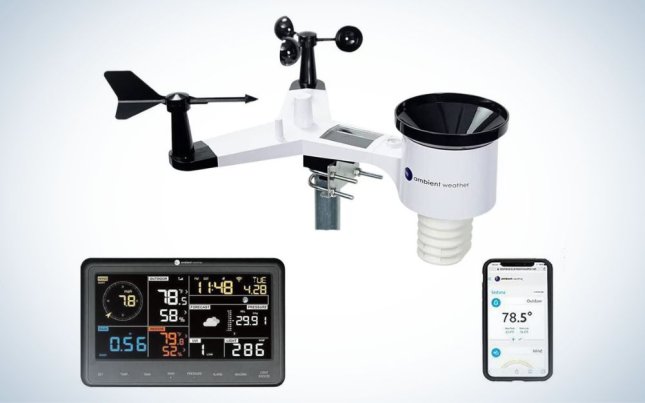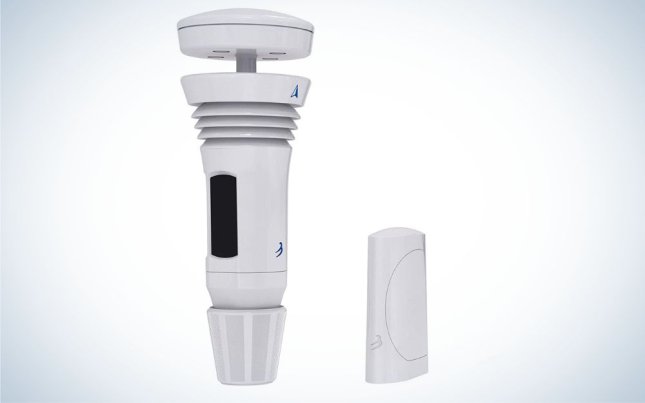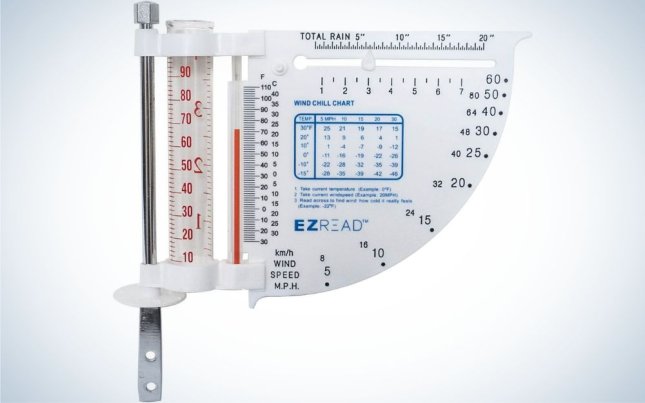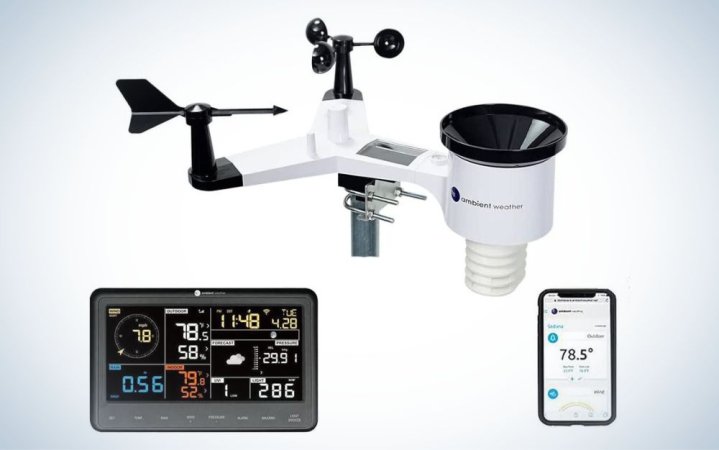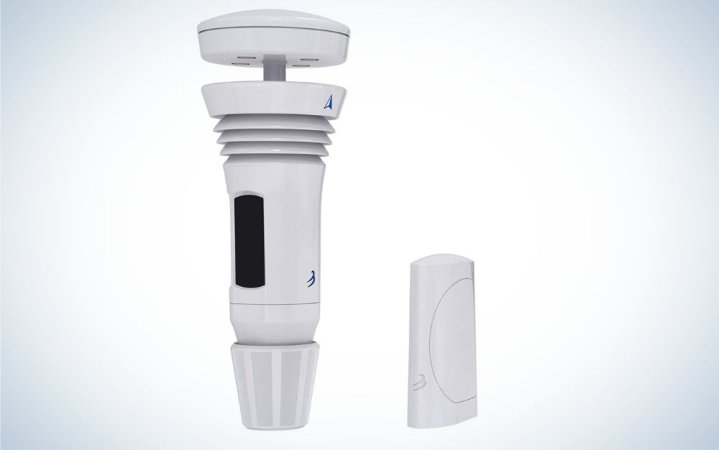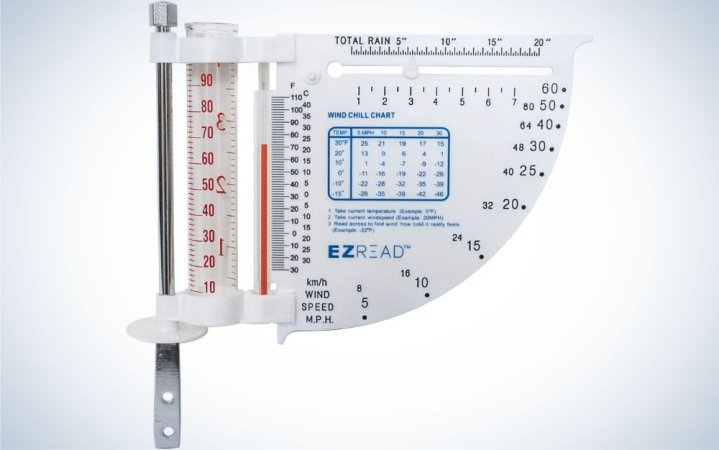We may earn revenue from the products available on this page and participate in affiliate programs. Learn more ›
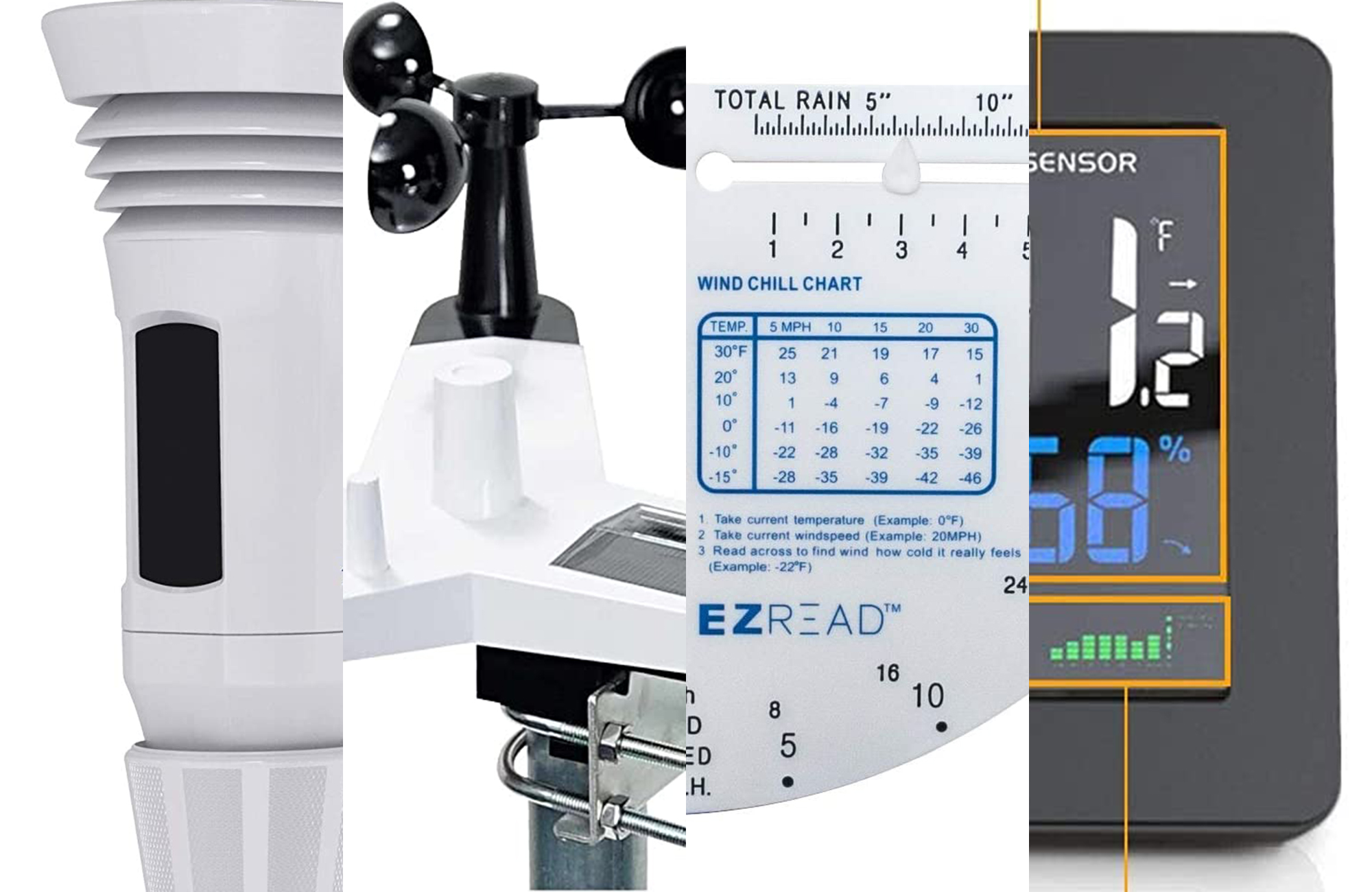
TV or an app can give you some general idea of what the weather is like around your living space, but a home weather station can paint a much more accurate picture. These devices measure everything from wind speed to barometric pressure. Our best overall choice, the Ambient Weather WS-2902C offers a robust set of instruments and a handy built-in Wi-Fi connection for simple monitoring and tracking. The best home weather station for you depends on your specific needs and budget, so here are some options to consider.
- Best overall: Ambient Weather WS-2902C WiFi Smart Weather Station
- Best for the money: Tempest Weather System
- Best with wind speed: WeatherFlow WEATHERmeter
- Best basic: EZRead Headwind Consumer Products 840-0052 5-in-1 Weather Station
- Best budget: Newentor Weather Station
How we chose the best home weather stations
I have experience with consumer weather station usage in a field environment, as per my previous career in the sciences. Used for much the same reason that anyone would want a personal home weather station—the desire to know very local meteorological conditions—I have a bit of insight into what you might desire from a home weather station. Not to mention what problems you might face! For, as it turns out, when you have instruments measuring weather, you also have to open them up to the weather, a not always friendly beast. I combined that experience with critical reviews and online user impressions to select our top five models for home weather stations.
The best home weather stations: Reviews & Recommendations
The home weather stations we’ve collected vary in style, functionality, and pricing so that you’ll be able to find something that fits your desires. We’ve also looked at what you’re looking for, such as compatibility with the Google Home system, and found top-ranking products that match those desires.
Best overall: Ambient Weather WS-2902C WiFi Smart Weather Station
Pros
- Solar-powered measurement station
- Connects with Ambient Weather system
- Quick setup
Cons
- Measurement station and display device use different types of batteries
Why it made the cut: The Ambient Weather WS-2902C is Amazon’s best-rated home weather station and has robust weather monitoring capabilities.
Specs
- Measures: Wind speed and direction, temperature, humidity, rainfall, UV and solar radiation
- Power supply: Solar with AA-battery backup
- Sensor size: 15 x 11 x 10 inches
- Price: $189
The first home weather station, and the overall winner on our list, is the Ambient Weather WS-2902C. The WS-2902C earns this distinction by having appealing features and being the best-rated home weather station by online shoppers.
First and foremost is the easy setup-and-forget nature of this home weather station. After taking a few minutes to place it on a pole and connect it to your WiFi network, you won’t find yourself fiddling with it often. Part of this is because of its hybrid solar and battery-powered measurement unit. Another important aspect is how easily accessible your data is via the Ambient Weather app environment.
One of the main problems I found with the product was that the display device and measurement stations used different types of batteries—the former taking AAA’s and the latter taking AA’s (may we recommend rechargeables). Admittedly, this is a minor problem, as the display device can be plugged in and the measurement station only needs batteries for cloudy days.
At the end of the day, this is a fantastic wireless weather station that also has nice power-saving features, making it amongst the best eco-friendly home weather stations as well. All for a sub-$200 price point!
Best for the money: Tempest Weather System
Best for the money
Pros
- Downward-facing intakes on measurement device
- Solar-powered
- Works well with Google Home
- 1,000+ foot wireless data transmission range
Cons
- Periodic measurement quirks
Why it made the cut: The Tempest Weather System provides information on par with a professional weather system but at a much more affordable price.
Specs
- Things measured: Temperature, “feels like” temperature, solar and UV radiation, wind speed and direction, dew point, humidity, barometric pressure, lightning strikes, rainfall
- Power supply: Solar with lithium-ion battery backup
- Sensor size: 11.70 x 4.23 inches
- Price: $339
The Tempest Weather System provides a myriad of data points in a well-designed package. With the Tempest reporting around a dozen weather stats, it is hard to believe that it has no moving parts, reducing the impacts of age and wear and tear on the system. Furthermore, the design ensures any openings are downwards-facing, reducing the chances of clogging.
Unlike many home weather systems, the Tempest Weather System does not have an indoor display unit. Instead, the Tempest Weather Station is “smart” and updates every 3 seconds to 1 minute to a wireless transmission hub you can locate within 1,000 feet of the weather station. From there, info is sent to your smartphone(s) and Internet-of-Things devices. This includes Google Assistant, making it the best weather station for Google Home. You can then use the data to program your smart home, such as by having fans turn on or off depending on temperature readings given by the device.
All of this advanced measurement isn’t 100% perfect, but once you understand the quirks, you’ll be able to get a good read. The rain gauge, for example, uses touch-based vibrational sensors to get a reading. Each pitter-patter of rain on the side gets interpreted as a raindrop. That’s great, but sometimes other vibrations or small things hitting in on the windiest of days will also set it into rain gauge mode. The lightning detection has its own quirks, with user reviews mentioning that the Tempest Weather Station has mistaken gunshots for lightning. However, once these small quirks are acknowledged and accounted for, you are left with the best home weather station for the money due to just how much it can do.
Best with wind speed: WeatherFlow WEATHERmeter
Best with wind speed
Pros
- High mobility
- Works directly with your phone
- Gives detailed wind speed analysis
- Multiple app integrations
Cons
- Uses phone’s compass instead of providing one
Why it made the cut: The WeatherFlow WEATHERmeter is your personal handheld view into the world of wind.
Specs
- Things measured: Average wind speed, wind gust, apparent wind speed, true wind speed, wind direction, temperature, humidity, pressure, dew point, heat index, wind chill, etc.
- Power supply: Internal battery
- Size: Handheld
- Price: $92
If you’re here just to know about wind speed, you’ll be delighted with the handheld WeatherFlow WEATHERmeter. This version is the newest update to the popular 2019 model and has the capability to give you a detailed look at your immediate wind conditions, making it a perfect golf, kiting, or overall nature companion.
One interesting thing that the WeatherFlow WEATHERmeter will tell you is both the apparent wind speed and true wind speed. The apparent wind speed tells you how fast the wind is going relative to the device, while the true wind speed gives a measure of how fast the wind is actually going. The WeatherFlow WEATHERmeter also reports gust wind speeds and average wind speeds.
The makers of the WeatherFlow WEATHERmeter clearly have the hobbyist in mind and that shows more in the selection of apps you can use it with than with any other factor. Pair this weather station with any of the following six apps: Wind & Weather Meter, iKiteSurf, iWindSurf, SailFlow, FishWeather, and WindAlert.
What might disappoint you about the WeatherFlow WEATHERmeter is the lack of an internal compass. Instead, you must rely on your phone’s compass for accurate wind direction readouts. However, we wouldn’t count this as too bad of a tradeoff, considering phone compasses are getting better every year, and you are able to get such an advanced wind meter in such a convenient-to-carry form.
Best basic: EZRead Headwind Consumer Products 840-0052 5-in-1 Weather Station
Best basic
Pros
- Highly educational
- Easy to install and clean
- Measures more than expected
- Inexpensive
Cons
- Tiny measurement display can’t be read from window
Why it made the cut: This analog weather station gives you a hands-on read of your local weather conditions.
Specs
- Things measured: Temperature, wind chill, rainfall, total rain, wind speed and direction
- Power supply: N/A; completely analog
- Item size: 1 x 8 x 10 inches
- Price: $16
For the weather hobbyist who wants to understand the weather in a way that transcends digital charts and displays, the EZRead 840-0052 is the best home weather station. Considering that it is only ~$20, the EZRead can also be bought in bulk, making it also ranked as the best weather station for kids and student projects.
To get started using the EZRead the only thing you’ll need to do is mount it and wait for weather to happen. The mounting process is relatively simple, as the metal frame has two preconfigured holes in it, which Headwind Consumer Products recommends affixing to a fence or patio support, but feel free to be creative.
The EZRead measures a surprising quantity of things, including total rain and wind speed, and does so in both the good ole American Imperial units and the more scientifically customary metric units. The EZRead has a wind chill chart directly on the device, to help you convert the thermometer’s temperature to a “feels like” number. In this way, this home weather station will become an arithmetic booster for your kids and bridge the gap between science, math, and reality.
Finally, for all that has been said about cleaning tubes and open holes in home weather stations, it must be said that nothing can be easier to clean than the rain gauge on the EZRead. It is essentially a removable graduated cylinder and can be cleaned with a vase or pipe cleaner quickly. The manufacturer recommends this rain gauge part be turned upside down during freezing weather to prevent damage, but it can just as easily be moved inside.
Best budget: Newentor Weather Station
Best budget
Pros
- Also includes the atomic clock, weather forecast, and lunar phase
- Display unit can accommodate up to 3 sensors
- Gets the fundamentals right without charging you extra
Cons
- Limited valid sensor placements
Why it made the cut: This home weather station provides you with the reading and stats you really want without the extra costs and hassles of a premium model.
Specs
- Things measured: Temperature and humidity
- Power supply: AA batteries
- Display size: 7.5 inches
- Price: $44
If the main thing you want to know is how hot of a summer day you are about to face and how much humidity will be bearing down on you, consider looking no further than the Newentor Weather Station. You aren’t being charged extra for delicate wind meters and rain gauges, and the whole apparatus is supplemented by local weather forecasts. This is definitely the best home weather station for those in rural areas where the local station’s rain forecast is good enough, but local humidity and temperature change wildly based on local hills, mountains, rivers, and lakes.
This home weather station’s indoor display unit will also give you additional information, such as the time from the WWVB atomic clock system, a weather forecast, the current moon phase, and a mini calendar. A happy/sad/neutral face system will tell you about the outside weather conditions, and there are optional temperature alerts. The Newentor should sync with the WWVB system within about 24 hours of initial use, after which all time-based additional features will begin working.
The sensors (this package comes with one, but you can order up to two more for the system) can be installed within 200 feet of your indoor display unit, but some care must be taken in this. Newentor recommends a North-facing wall and that the unit be out of the way of rain and direct sunlight. In my eyes, this makes a North-facing patio the best place for installation, but your personal circumstances may vary. Additionally, the unit requires two AA batteries.
Finally, while our best basic product (the EZRead, discussed above) is technically the cheapest home weather station on our list, we’ve listed this as our best budget pick. The reasoning is simple: The Newentor Weather Station is the best digital weather station under $50.
Things to consider before buying the best home weather stations
When you first decided to buy a home weather station, you probably excitedly asked yourself a few questions, such as: Can a home weather station measure more than temperature and humidity? Can I get one that is affordable? Where will I be able to put the measuring devices?
As it turns out, there are quite a few things that you will need to consider when making a home weather station purchase that aren’t that obvious, including:
Instrument type
The big four for home weather stations are temperature, humidity, wind speed, and wind direction. Nearly all home weather stations can measure these, but there are things that you might want to measured, such as the UV radiation level, that are nice to know and can add extra usefulness to your system. Some of our best home weather station picks can also measure other stats, such as dew point, lightning strikes, and gust wind speed.
One issue is that you may discover you don’t really want or need all the measurements provided by a given home weather station. While being able to measure a lot of different things looks great for marketing, it also drives up costs. For many people, a home weather station that is able to measure a few things well is better than a home weather station that can measure dozens of things.
Additionally, as we’ll see in the next category, you should also consider the ability of each thing to be measured properly based on your local environment. Based on the instrument positioning, see below, measuring rainfall might be difficult if you’re wanting to set up your home weather station near a small-leafed bush.
Instrument positioning
Instrument positioning will likely be the most important, but also most obscure, factor that determines your overall happiness with your home weather station. One of the unfortunate parts of being a weather machine is that you have to experience a lot of, well, weather and nature. You’ll want to think about where you are going to put your home weather station’s measurement device as well as where any intake holes are placed on it.
Commonly, difficulties with instrument positioning will present themselves in an upward-facing hole, usually as part of the rain gauge. One aesthetically pleasing, but operationally sub-optimal installation onto a pole that has a bird feeder or bird house, and you’ve got a major problem: bits of seeds or bird excrement clogging up your home weather station.
Other sources of problems include foliage blocking wind meters, mowed lawns kicking up grass into side-facing holes, and overheating equipment. Not all devices are made to withstand all conditions. You want one that’s durable and then you want it positioned thoughtfully so you can, say, find out how much action your home wind turbine might get today or whether you need to be worried for your solar generator’s panels.
Power supply
Are you going with a battery or a wire for your home weather station? The answer to this question is going to be very important for the quality of interactions you have with your home weather station.
While you might think that the choice will come down to having a wired model or something with a battery, the reality is a bit different. Some models tend to work off of solar power, with a battery used as a backup, while other models use solely batteries. We’ll be presenting a mixture of both styles to you, as each can be appealing at certain price ranges and functionalities.
We also have a very basic analog product, the EZRead Headwind Consumer Products 840-0052 5-in-1 Weather Station. This one forgoes the whole power supply problem altogether and relies solely on the power of wind and gravity to make it work.
FAQs
A home weather station can cost anywhere from $20 for an analog reader to over $300 for an advanced digital model. Modern-day weather enthusiasts should aim to find something that is around $300, but anyone can find a great, workable model for less. When pricing home weather stations, balance your needs with what the station provides. For example, avoid paying top dollar for a home weather station that will count local lightning strikes if all you want is something that can tell you the current temperature and humidity.
Home weather stations should be located near the home, in the environment specified by the manufacturer. Budget-friendly home weather stations might do worse in direct sunlight, while solar-powered home weather stations clearly need direct sunlight. Our write-ups on each of the best home weather stations should give you an idea of whether the station is right for your home.
Home weather stations are worth it if you have a burning desire to know about hyper-local weather, typically get inaccurate results from your local weather station as a result of special geographic concerns, or certain weather factors influence your life heavily. For example, if you live on the East side of a mountain, but your local weather station is on the West side of it, a home weather station will turn out to be more accurate. Another example is golf and gardening enthusiasts, who will find very local wind and humidity readings very useful.
Final thoughts on the best home weather stations
- Best overall: Ambient Weather WS-2902C WiFi Smart Weather Station
- Best for the money: Tempest Weather System
- Best with wind speed: WeatherFlow WEATHERmeter
- Best basic: EZRead Headwind Consumer Products 840-0052 5-in-1 Weather Station
- Best budget: Newentor Weather Station
Getting one of the best home weather stations means getting quality without having to spend the sometimes exorbitant amounts for professional weather stations that meteorologists use. Even basic analog weather stations like the EZRead can provide value to the right person, but we recommend the Ambient Weather WS-2902C WiFi Smart Weather Station for the right blend of quality and cost. If you’re still not convinced to buy a home weather station, you can also try making your own.
